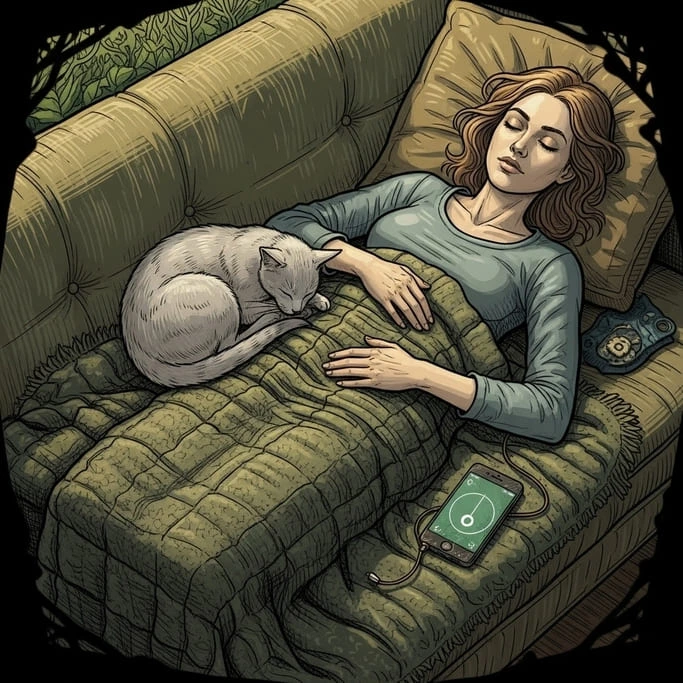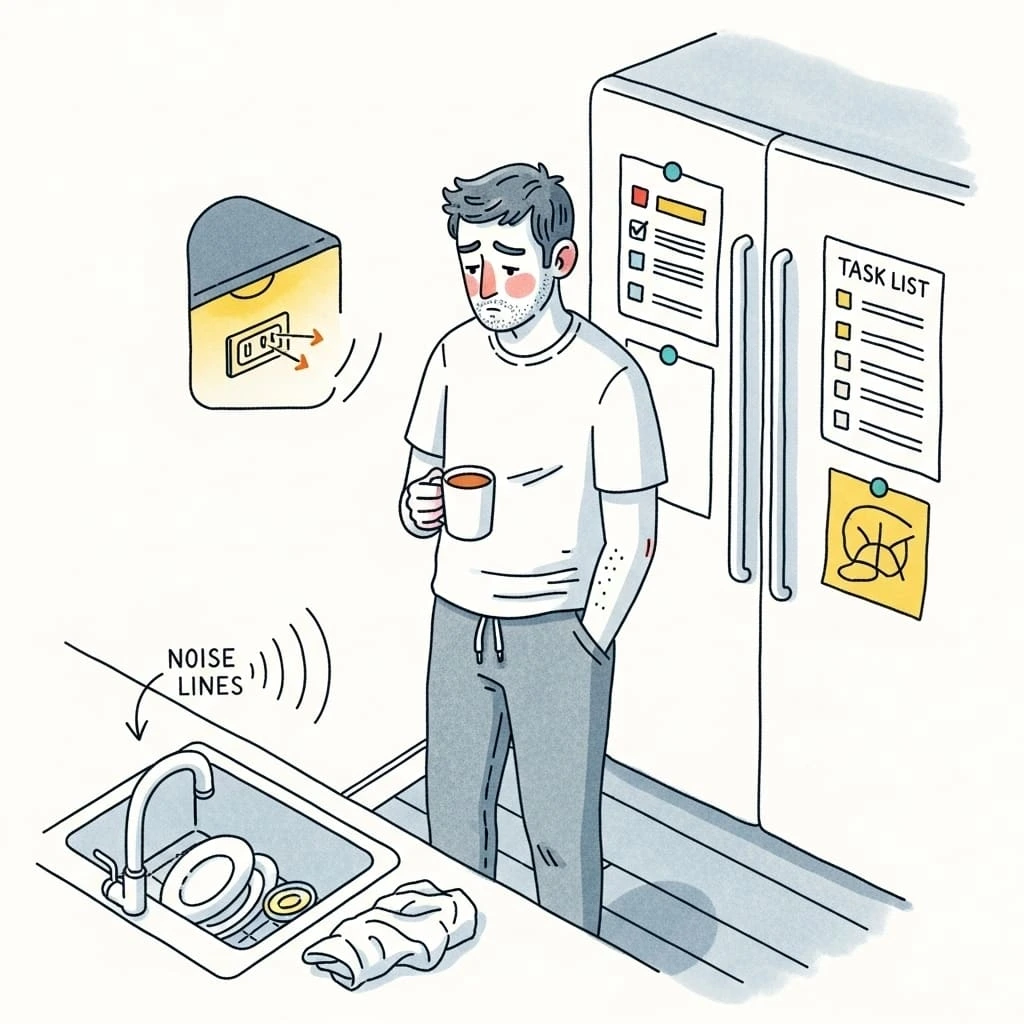Recovering from autistic burnout is a profoundly personal journey, yet one that many autistic people face at some point in their lives. Raising awareness about the signs and causes, we can help more autistic people recognise when they are reaching their limits and take proactive steps toward recovery. Implementing self-care strategies, creating calming routines, and setting clear boundaries protect mental and physical energy. With the right understanding and tools, recovery becomes possible and encouraging.
What Causes Autistic Burnout?
Autistic burnout isn’t caused by one single thing, and it’s the cumulative effect of chronic stress, sustained masking, and living in environments that don’t fit one person’s neurology. It also happens when life’s demands are too high for too long, and those who struggle may feel guilty about needing to rest and recharge.
📌 Key point:
Burnout happens when energy is continually drained without enough opportunities for replenishment. The risk is highest when masking and environmental mismatch occur together for months or years.
The common causes of autistic burnout are often linked to specific burnout symptoms:
- Masking for long periods
What it is: Suppressing autistic traits to be seen as non-autistic by neurotypical people in the neurotypical world – changing speech, body language, facial expressions, interests, or sensory behaviours.
Why it’s a ‘problem’: Autistic masking uses huge mental energy. Studies show it’s strongly linked to burnout, anxiety and depression in autistic people, who are often easily triggered by various stimuli.
- Chronic sensory overload or deprivation
Overload: Continuous exposure to sensory triggers like noise, lights, smells, touch, or crowded spaces can lead to increased sensitivity without adequate breaks, highlighting the need for more rest.
Deprivation: Denying necessary sensory input (stimming, weighted blankets, or movement) increases stress and affects emotional regulation.
Why it matters: The nervous system stays in a heightened state, wearing down resilience.
- More demands than support
Burnout builds when what life asks from you is greater than the help and resources you have. This can be work pressure, academic deadlines, household tasks, or even too many social events, all contributing to the challenge of creating a sustainable life.
Without enough support, like flexible schedules, sensory-friendly spaces, or understanding from others, the gap between what’s expected and possible grows until it becomes unmanageable.

- Major life changes
Transitions like starting a new job, moving house, or beginning university can be exciting but overwhelming. For autistic people, adjusting to new routines, noisy environments, and expectations can make them feel overwhelmed, taking far more energy than others realise. Even positive changes can push someone closer to burnout if they pile on top of existing demands.
- Barriers to а recovery process
Burnout lasts longer when people are pressured to “get over it” quickly or when support systems don’t understand what’s happening. Recovery stalls and burnout can become a cycle without space to rest, adapt environments, and reduce demands.
You can read more about managing autistic burnout here.
Strategies for Autistic Burnout Recovery
Burnout doesn’t happen overnight or come with a pair of ‘quick fixes’. What once started as overfunctioning, masking the personality, or neglecting one’s actual sensory needs, comes at a significant cost, leading to experiencing autistic burnout. It won’t be simple, but the recovery often starts with self-knowledge and understanding how to recover from autistic burnout, having a plan and a daily reminder to limit how much energy a person has and what draining activities won’t give the peace one deserves. Recovering from autistic burnout usually calls for a profound reshaping of life, where autistic adults pause to reassess their core values, set new boundaries, and build a lifestyle that honours their needs while being sustainable over the long term.
Let’s detail the most common strategies and how they can help an autistic person.
Step 1: Immediate Recovery Actions
Undertaking immediate recovery actions may look different for each person. People’s journeys are diverse, and they have different needs and goals. These actions vary exactly from the very different practices that can help a person regain their energy from the cycle of autistic burnout.
Making the first step towards recovery means everything, and these immediate actions can stop further energy drain, protect the nervous system and create conditions for long-term recovery:
- Lower all non-essential demands (cancel, postpone, or delegate tasks that aren’t critical for safety, health, or essential daily living)
- Create a low-sensory safe space (use blackout curtains, noise-cancelling headphones, weighted blankets, soft lighting)
- Stop or reduce masking where safe (allow stimming, minimise eye contact, speak in your natural style)
- Rest without pressure (spend time taking naps, quiet time, do your favourite hobby without a goal or a deadline, minimise social interactions)
- Ask for immediate adjustments (Request urgent, reasonable adjustments at work, school, or with services under the Equality Act 2010, such as quieter work areas, flexible hours, remote working days, or reduced workload temporarily)
- Schedule sensory breaks daily (alone time, walks, deep-pressure activities)
Step 2: Self-Care
Recovery is not linear. Some days will feel better than others. The focus is on reducing demands, replenishing energy, and adapting your sensory environment and routines. Compassion toward yourself is the most important part of self-care.
Self-care is a step closer to living more in peace with yourself, so choose to:
- Prioritise rest and downtime.
- Reintroduce activities gradually – start with 10-20% of your usual load and increase slowly.
- Share your recovery plan with trusted people to reduce pressure and expectations.
- Do what you love, and be surrounded with the people and pets you love! It is restorative.
- Replace self-criticism with phrases like: “It’s okay to rest,” “I am recovering at my own pace,” or “I deserve support.”
- Eat regular, nutritious meals, take nature walks and stay hydrated.
- Prioritise sleep hygiene and consistent routines.
- Use autism-informed therapies if needed.


Step 3: Emotional Support
Emotional support in autistic burnout is about validation, understanding, autonomy, and gentle reconnection, not forcing productivity or masking. Recovery happens when your mind is allowed space to rest, utilising your internal resources, process difficult emotions, and rebuild, alongside practical supports.
Based on people with lived experience, emotional support for autistic burnout recovery feels like:
- Connecting with people who understand you, peers and the autistic community.
- Surround yourself with people who accept autistic traits without judgment, and seek support.
- Autism-informed therapeutic support can help with anxiety, depression, or trauma.
- Letting friends, family, and colleagues know your current limits.
- Making small decisions about your day, routines, or self-care.
- Tracking moods and stress levels in simple ways: diary, app, or visual chart.
Step 4: Create a Supportive Environment
Even when professional autism-informed support is present, burnout recovery depends on respecting energy limits, creating sensory and emotional safety, and giving the autistic person control over their environment.
What needs to be done:
- Control lighting, sound, and temperature. Soft lamps, quiet areas, and noise-cancelling headphones help.
- Have access to calming objects or activities: weighted blankets, fidget items, favourite music.
- Keep spaces predictable and organised to reduce mental load to avoid difficulties with executive functioning.
- Reducing environmental stressors that contributed to burnout in the first place.
Step 5: Gentle Rebuilding and Prevention
Gentle rebuilding and prevention is about recovery at the person’s pace, restoring what burnout has taken, and redesigning life to protect against future burnout. It’s restorative and proactive, combining personal pacing, environmental adjustments, and preventive strategies.
Here’s a breakdown of its key focuses:
- Slowly reintroducing activities and responsibilities in manageable steps.
- Even ten minutes of doing what feels natural matters.
- Allowing the nervous system to recover fully before increasing load.
- Learning to recognise signs of rising stress or sensory overload before they reach a critical point.
- Tracking energy levels, triggers, and fatigue to pace life accordingly.
The Recovery Mindset: It’s Okay to Slow Down
Autistic burnout brings extreme exhaustion, difficulty thinking clearly, heightened sensory stimulation, or a loss of skills. It can last weeks, months, or even longer. Rushing back to old routines or pushing through fatigue won’t help when all the mind and body need is to slow down, listen to yourself, and create a space to heal.
The first step in recovery is to accept your current state without judgment. Burnout is not a personal failure. It is your nervous system’s way of signalling that life has been too demanding for prolonged periods. Accepting this truth allows you to step back from pressure, guilt, or the idea that you must immediately “catch up.” It is okay to rest. It is okay to do less. Finally, recovery is about planning for sustainable changes. Slowly reintroduce responsibilities in manageable steps, maintain boundaries, and maintain self-care routines. Monitor for early warning signs of burnout, such as chronic fatigue, heightened sensory sensitivity, or increased social withdrawal, and adjust accordingly.
Remember, slowing down is allowed, boundaries are necessary, and your mental health and well-being come first.
Autism Support with Unique Community Services
At Unique Community Services, our autism support is built on the foundations of the Autism Strategy, ensuring every aspect of care and support meets the highest legal and ethical standards.
Our approach is:
- Person-centred and Autism-informed – developed entirely around each person’s unique strengths, needs and goals by our therapy and support teams.
- Integrated and collaborative – working with health, social care, and community partners.
- Preventive and proactive – anticipating needs and supporting well-being before challenges escalate.
Focusing on reducing crises to enable people to live a life that matters to them, we involve the autistic person in decision-making about their support, whenever possible, alongside their families and stakeholders.
Watch William’s documentary through the eyes of our Registered Manager, Carol Taylor, and Care Coordinator, Paula Howard. Witness how collaborative care has encouraged William to live life on his own terms.
Refer and see the difference with the Unique Community Services’ team.
Offices: Manchester and Leeds




